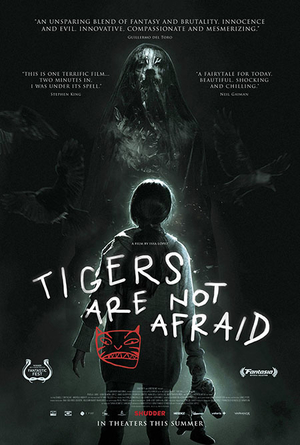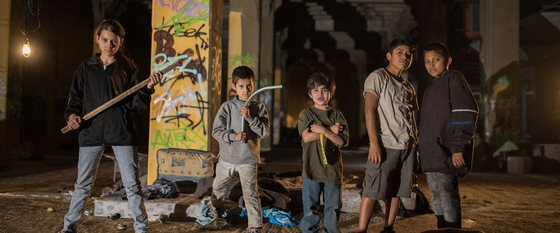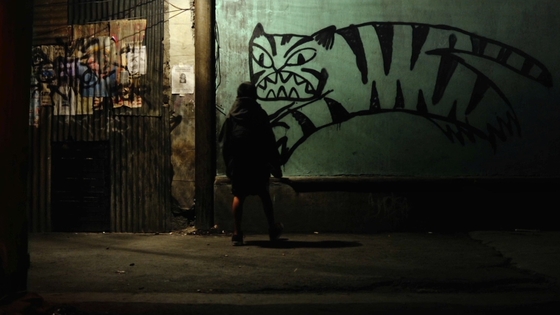

[Rating:Minor Rock Fist Up]
Issa Lopez’s Tigers Are Not Afraid begins in a classroom as a group of eager students answer their teacher’s question by sharing what elements of a fairytale are the most important.
Foreshadowing the elements the director takes on in her own cinematic fairy tale, the introduction effectively establishes a mystic tone and the fear that violence could break out at any minute. Instead of a magically grim story taking place in the woods of Germany hundreds of years ago, Lopez sets her story in a modern-day Mexico city in the midst of the drug war. Giant talking wolves and evil stepmothers are replaced by more realistically terrifying villains in the form of the Cartel.
Tigers Are Not Afraid takes on the magical-realist style and centers around a group of lovable children trying to survive in a world in which no child should have to live. The film is labeled as horror but in most aspects fear is replaced with fantasy. Lopez however never lets the high stakes needed for effective horror falter in its instead more mystical setting.
Happy endings are not a given in real life and Lopez’s film is the same way. There are scenes of great joy and there are scenes of great brutality. Lopez balances a lot in the film’s tone and although it doesn’t pay off perfectly, the creativity and performances make for an incredibly rewarding viewing experience.
Taking place after members of the Cartel have violently taken control of a city, young Estrella (Paola Lara) now finds herself without her mother and but three magical wishes. Given in the form of chalk, Estrella and the film’s reality blur due to the power of the wishes and the haunting of her tragic past come to life. Like most stories with three wishes, the outcomes are not always as hopeful as they seem. In this way Estrella’s fantasy can easily turn into a nightmare, bringing about what horror aspects the film has.
Estrella is taken in by a rebellious group of orphans who strive in a city that is post-apocalyptic in look and feel. Led by a rugged young boy named Shine (Juan Ramon Lopez), the adolescent group that refer to themselves as Tigers roam the empty streets that have become their home and fight to survive the night by any means necessary.

For a film revolving around the lives of children to be successful, the filmmaker must properly capture authenticity of what it’s like to be a child. There are many soulless films stained with artificial child archetypes, because the writers and director didn’t properly capture the essence of a child. This essence can be easily overlooked, but crucial to failure as it is something that any person watching a film can relate to in one way or another.
This challenge is exceptionally difficult for Lopez as she handles such a young age group of children who are simultaneously forced into the most adult situations one can be in by providing for themselves. There is a lot of complexity in handling these characters, but Lopez deals with it nicely and is with it provides power to the film. In the film’s short runtime, each of the children become important to the viewer. The thrills are found during moments of suspense, but the most memorable scenes are when Lopez simply lets them be children. In what could be meaningless scenes of watching children play, the film lets its guard down as the characters do the same. These scenes explore the idea that there is a universal joy in children that can never vanquish even in the most stressful of situations.
Complimenting how well the child characters are handled in the film, the performances by the actors are outstanding. The casting department deserves a thunderous amount of applause for how they found young actors to perfectly fit these roles. From Juan Roman Lopez’s inherent gruff found in a boy who is forced to take on the responsibility of a man, to Paola Lara’s portrayal of a young girl trying to maintain her childhood innocence in a circumstances that aggressively attempt to strip it away, the ensemble of the children work tremendously together and will be highlight for anyone that watches.

Even with all that is great about it, however, Tigers Are Not Afraid never escapes the feeling that it lacks in substance. There are so many inventive ideas that flourish in the film that are almost discredited because of how thin of a plot there is. The climax isn’t worthy of the build and is rushed near the end. The film is stuck between a well-crafted character study uniquely mixed with surreal spectacles while also being tied down to a connect-the-dots B-movie plot. The voyeuristic examination of the characters is the richest part of the film, but Lopez relies on the fairy-tale structure to a fault and forces a half-baked narrative.
The dramatic moments near the end of the film still take an emotional toll, but lack the imagination that surrounds it. The film submits to a more traditional storytelling in the second half when it would have been better without. Showing the good and bad of children behaving as children, is where the heart of the film is formed. It is also what provides for the most thought-provoking moments that arise to the young subjects in such a cruel environment.





Comments on this entry are closed.